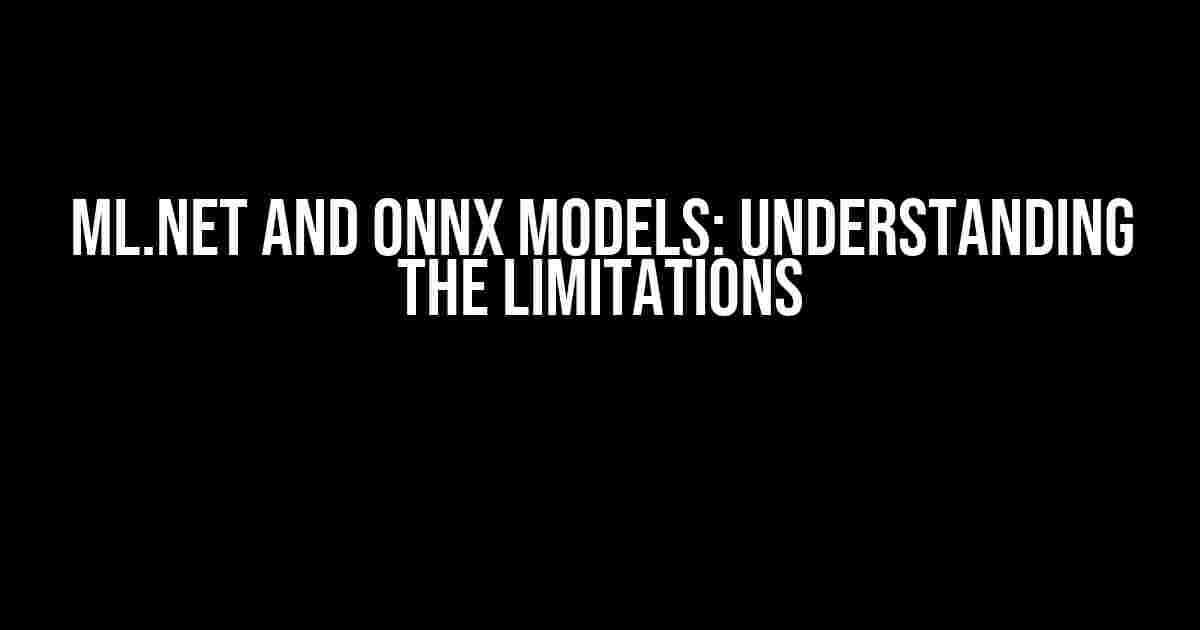Are you trying to integrate an ONNX model into your ML.NET project, only to find that the ApplyOnnxModel method is nowhere to be found? Don’t worry, you’re not alone! In this article, we’ll delve into the reasons behind this limitation and explore alternative solutions to help you get started with ONNX models in ML.NET.
What is ML.NET?
ML.NET is a cross-platform, open-source machine learning framework developed by Microsoft. It allows developers to integrate machine learning models into .NET applications, making it easier to build intelligent systems. ML.NET supports various types of models, including TensorFlow, ONNX, and Caffe.
What is ONNX?
ONNX (Open Neural Network Exchange) is an open format for representing machine learning models. It enables developers to export and import models between different frameworks and environments, making it a widely adopted standard in the machine learning community. ONNX models can be converted from popular frameworks like TensorFlow, PyTorch, and Caffe, allowing for seamless integration across different platforms.
Why doesn’t ML.NET have ApplyOnnxModel?
The main reason ML.NET doesn’t have a built-in ApplyOnnxModel method is due to the complexity of handling ONNX models. Unlike other frameworks, ML.NET focuses on providing a high-level API for building and integrating machine learning models, rather than providing direct support for specific formats like ONNX.
However, this doesn’t mean you can’t use ONNX models in ML.NET. You can still leverage the power of ONNX models by converting them to a format compatible with ML.NET or by using third-party libraries that provide ONNX support.
Converting ONNX Models to ML.NET Compatible Format
To use an ONNX model in ML.NET, you need to convert it to a compatible format. There are a few ways to do this:
onnx2mlnet: This is a command-line tool provided by Microsoft that converts ONNX models to ML.NET compatible format.MlNetOnnxConverter: This is a .NET library that allows you to convert ONNX models to ML.NET compatible format programmatically.
using MlNetOnnxConverter;
// Load the ONNX model
var onnxModel = File.ReadAllBytes("model.onnx");
// Convert the ONNX model to ML.NET compatible format
var mlNetModel = OnnxConverter.Convert(onnxModel);
// Save the converted model
File.WriteAllBytes("model.zip", mlNetModel);
Using Third-Party Libraries for ONNX Support
Another way to use ONNX models in ML.NET is by leveraging third-party libraries that provide ONNX support. Some popular libraries include:
Microsoft.ML.OnnxRuntime: This library provides a runtime environment for executing ONNX models.ONNX.NET: This library provides a .NET wrapper for the ONNX runtime, allowing you to execute ONNX models in .NET applications.
using Microsoft.ML.OnnxRuntime;
// Load the ONNX model
var onnxModel = File.ReadAllBytes("model.onnx");
// Create an ONNX runtime environment
var runtime = new OnnxRuntime:onnxModel);
// Execute the ONNX model
var input = new[] { new[] { 1.0f, 2.0f, 3.0f } };
var output = runtime.Run(new[] { input });
Conclusion
In conclusion, while ML.NET doesn’t have a built-in ApplyOnnxModel method, it’s still possible to use ONNX models in your ML.NET projects. By converting ONNX models to a compatible format or using third-party libraries, you can leverage the power of ONNX models in your .NET applications.
Remember, the key to success lies in understanding the limitations of ML.NET and being willing to explore alternative solutions. With a little creativity and persistence, you can unlock the full potential of ONNX models in ML.NET.
| ONNX Model | Conversion Method | ML.NET Compatibility |
|---|---|---|
| TensorFlow | onnx2mlnet | Yes |
| PyTorch | MlNetOnnxConverter | Yes |
| Caffe | ONNX.NET | No |
Don’t forget to explore the official ML.NET documentation and ONNX community resources for more information on using ONNX models in ML.NET.
Additional Resources
If you’re interested in learning more about ML.NET and ONNX, here are some additional resources:
- ML.NET Documentation
- ONNX Official Website
- MlNetOnnxConverter GitHub Repository
- ONNX Runtime GitHub Repository
By following the instructions and guidelines outlined in this article, you’ll be well on your way to integrating ONNX models into your ML.NET projects. Happy coding!
Frequently Asked Question
Are you stuck with ML.NET and wondering why you can’t find the ApplyOnnxModel method? You’re not alone! Here are some FAQs to help you out:
Why was ApplyOnnxModel removed from ML.NET?
The ApplyOnnxModel method was indeed removed from ML.NET to simplify the overall architecture and improve performance. Microsoft decided to focus on more powerful and flexible APIs, making it easier for developers to integrate ONNX models into their .NET apps.
What’s the alternative to ApplyOnnxModel in ML.NET?
Fear not, dear developer! You can now use the ML.NETesters API to load and execute ONNX models. Specifically, you’ll want to use the MLContext.Classify or MLContext.Predict methods, depending on your model’s requirements. These methods provide a more flexible and efficient way to work with ONNX models.
Will I need to rewrite my existing code for ApplyOnnxModel?
Unfortunately, yes. Since ApplyOnnxModel is no longer available, you’ll need to update your code to use the new ML.NET APIs. But don’t worry, the changes are relatively straightforward, and you’ll benefit from the improved functionality and performance.
Are there any benefits to using the new ML.NET APIs?
Absolutely! The new APIs offer better performance, improved error handling, and more flexibility when working with ONNX models. You’ll also benefit from increased compatibility with other ML.NET features and a more streamlined development experience.
Where can I find more resources on using ML.NET with ONNX models?
Check out the official ML.NET documentation and tutorials on Microsoft’s website. You’ll find plenty of examples, guides, and samples to help you get started with using ONNX models in your .NET applications.




